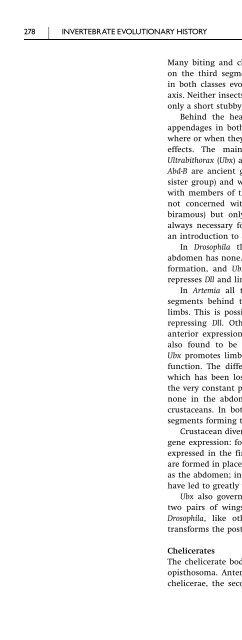An Introduction to the Invertebrates, Second Edition - tiera.ru
An Introduction to the Invertebrates, Second Edition - tiera.ru
An Introduction to the Invertebrates, Second Edition - tiera.ru
You also want an ePaper? Increase the reach of your titles
YUMPU automatically turns print PDFs into web optimized ePapers that Google loves.
278 INVERTEBRATE EVOLUTIONARY HISTORYMany biting and chewing insects and c<strong>ru</strong>staceans have mandibleson <strong>the</strong> third segment: fossil evidence suggests that <strong>the</strong> mandiblein both classes evolved from <strong>the</strong> whole limb by t<strong>ru</strong>ncation of <strong>the</strong>axis. Nei<strong>the</strong>r insects nor c<strong>ru</strong>staceans express Dll in this limb, so tha<strong>to</strong>nly a short stubby appendage can form.Behind <strong>the</strong> head, identical Hox genes govern <strong>the</strong> pattern ofappendages in both Drosophila and Artemia; differences in whe<strong>the</strong>r,where or when <strong>the</strong>y are expressed may cause <strong>the</strong>m <strong>to</strong> have differenteffects. The main Hox genes acting are <strong>An</strong>tennapedia (<strong>An</strong>tp),Ultrabithorax (Ubx) and Abdominal A and B (Abd-A and Abd-B). Ubx andAbd-B are ancient genes, shared with Onychophora (<strong>the</strong> arthropodsister group) and with <strong>the</strong> nema<strong>to</strong>de Caenorhabditis elegans, but notwith members of <strong>the</strong> o<strong>the</strong>r group of pro<strong>to</strong>s<strong>to</strong>mes. These genes arenot concerned with <strong>the</strong> nature of <strong>the</strong> limb (e.g. uniramous orbiramous) but only with whe<strong>the</strong>r and when it is formed. Dll isalways necessary for limbs <strong>to</strong> be fully formed (see Chapter 19 foran introduction <strong>to</strong> all <strong>the</strong>se genes).In Drosophila <strong>the</strong> thorax has three pairs of limbs and <strong>the</strong>abdomen has none. <strong>An</strong>tp is expressed in <strong>the</strong> thorax, promoting limbformation, and Ubx acts with Abd-A in <strong>the</strong> abdomen, where Ubxrepresses Dll and limb formation is prevented.In Artemia all three Hox genes are expressed <strong>to</strong>ge<strong>the</strong>r in allsegments behind <strong>the</strong> head and all <strong>the</strong>se segments bear (similar)limbs. This is possible because here Ubx can repress <strong>An</strong>tp withoutrepressing Dll. O<strong>the</strong>r c<strong>ru</strong>staceans are found <strong>to</strong> share this moreanterior expression of <strong>the</strong>se genes; <strong>the</strong> flexibility in Ubx action isalso found <strong>to</strong> be shared by o<strong>the</strong>r c<strong>ru</strong>staceans. In Onychophora,Ubx promotes limb formation, suggesting that this is its primitivefunction. The difference has been traced <strong>to</strong> a particular peptidewhich has been lost in <strong>the</strong> evolution of insects. This accounts for<strong>the</strong> very constant pattern of insect limbs (three pairs in <strong>the</strong> thorax,none in <strong>the</strong> abdomen), in contrast <strong>to</strong> <strong>the</strong> great variety found inc<strong>ru</strong>staceans. In both Drosophila and Artemia, Abd-B is expressed insegments forming <strong>the</strong> gonads.C<strong>ru</strong>stacean diversity is associated with many different patterns ofgene expression: for example, in isopods one of <strong>the</strong> ‘head’ genes isexpressed in <strong>the</strong> first thoracic segment, where feeding appendagesare formed in place of walking legs; barnacles have lost Abd-A as wellas <strong>the</strong> abdomen; in decapods alterations in Ubx and <strong>An</strong>tp expressionhave led <strong>to</strong> greatly varied limb specialisations.Ubx also governs wing formation in insects: most insects havetwo pairs of wings, on <strong>the</strong> second and third thoracic segments;Drosophila, like o<strong>the</strong>r Diptera, has only one pair, because Ubxtransforms <strong>the</strong> posterior pair in<strong>to</strong> halteres.CheliceratesThe chelicerate body is uniquely divided in<strong>to</strong> <strong>the</strong> prosoma and <strong>the</strong>opisthosoma. <strong>An</strong>tennae are <strong>to</strong>tally absent, <strong>the</strong> first segment bearschelicerae, <strong>the</strong> second bears pedipalps and <strong>the</strong> last four segments











